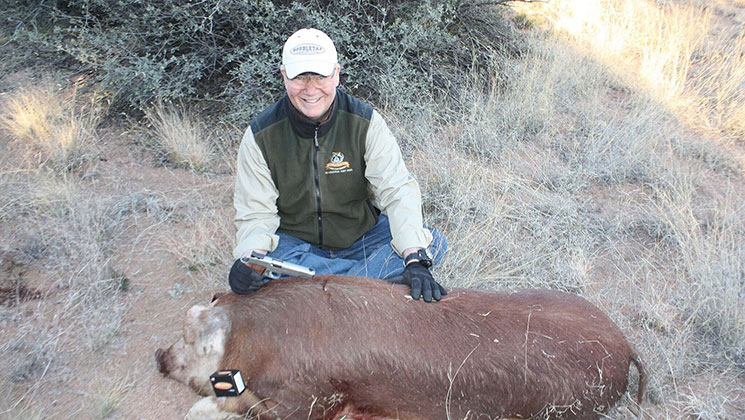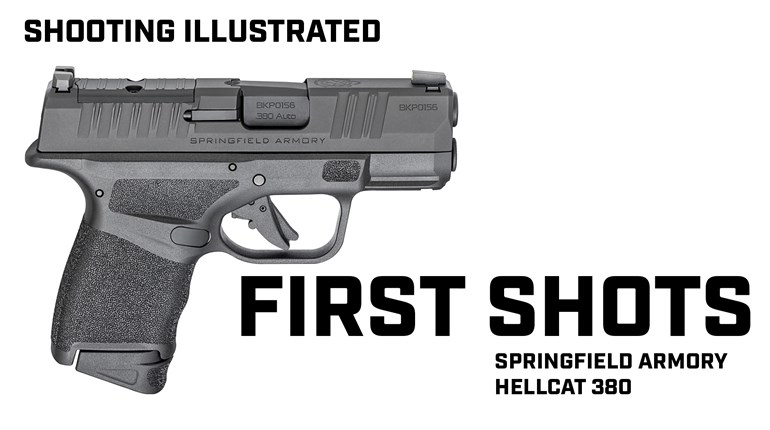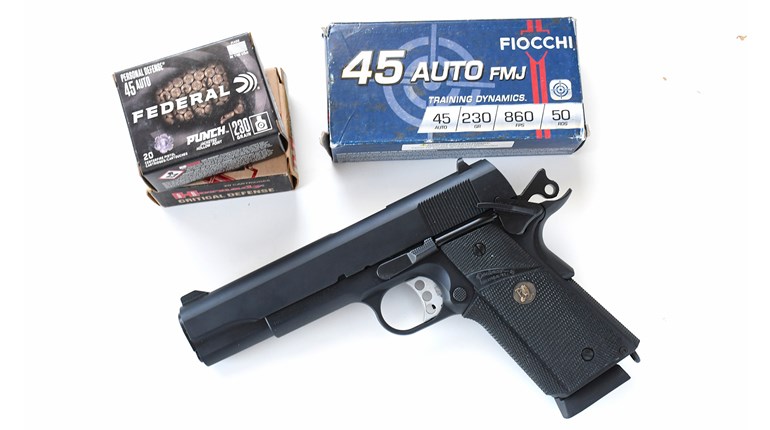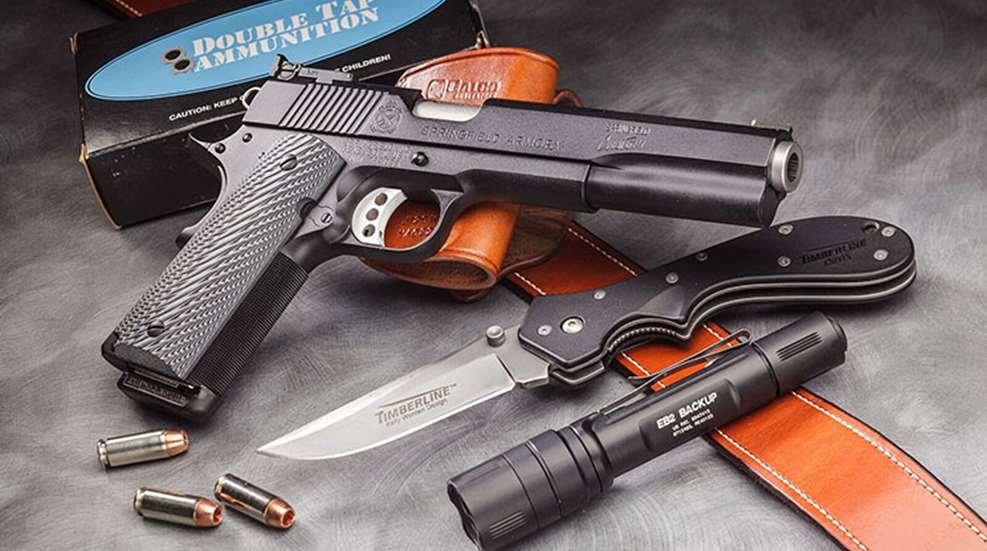
It began with a conversation at Tejon Ranch. For those of you who haven't had the pleasure of hunting the Tejon, it's a 270,000 acre ranch about an hour north of downtown Los Angeles that hosts seasonal hunts of elk, mule deer, turkey and various fur bearers along with year-round pig hunting. A few years back, under pressure from various state and special interest groups, the ranch agreed that all future hunts would be "lead free." That presented no problem for rifle hunters, as there were several manufacturers who loaded ammo with Barnes's excellent all copper bullets. But for the guides who venture into heavy brush after wounded pigs with handguns, it was a different story. Cutting to the chase, senior guide Cody Plank told me that he was having better results finishing wounded pigs with lead free 10 mm ammo than with lead-free .45 ACP. Since my favorite pistol is the Model 1911 and it happens to be the perfect host for the 10 mm cartridge, I wondered if we couldn't "maximize" the 1911 by chambering it in 10 mm.
A call to Dave Williams at Springfield Armory got the ball rolling. Dave runs the Springfield Custom Shop and won the American Pistolsmith's Guild prestigious Pistolsmith of the Year award a few years back. We kicked around some general specifications with Dave suggesting an extra inch of slide/barrel and the use of a Springfield Custom National Match barrel. The extra length might not handle as easily in a fast and furious defensive situation, but it would provide additional weight near the muzzle for quicker shot-to-shot recovery and could provide an extra few feet per second of velocity. It might also assist in making more precise shots at longer ranges. At this early stage in the planning process, I could not specify what load I planned to use, so Dave suggested an adjustable Bomar-style rear sight that would let me dial in the gun for whatever load I selected. Recognizing that pig hunting, particularly wounded pig hunting, generally takes place in thick cover in dim light, Dave ordered a SDM custom gold bead front sight for maximum visibility and left all edges of the sight blade sharply defined to ensure there would be no compromising the sight picture in bright daylight. At the time, I had no way of knowing how important that gold bead on the front sight would be. Since pig hunting (and self defense) is a year round activity, we needed something to ensure that sweaty hands would not compromise my shooting grip, particularly if rapid follow up shots were required. Dave installed G10 MILTAC grips from Craig Sword and engraved 25 lines per inch checkering on both front and back strap. I've used G10 grips on other pistols and have become a true fan. That's about as fancy as we got because this was to be a serious working/hunting handgun with an emphasis on functional rather than fancy. And yet there's nothing plain or “ho-hum” about the finished product as the picture will attest.
Next I called Mike McNett at DoubleTap Ammunition. Mike has made a name for himself in the 10 years he has been manufacturing high-quality ammo. More importantly for my mission, he began with the 10 mm round and has continued to expand the selection of this caliber to include a variety of loads. Because of the lead free premise that triggered this column, I focused immediately on the 155-grain all-copper Barnes JHP load even though I would normally have selected something heavier for general purpose pig hunting. Being a former marine rather than an ivory tower scientist, Mike uses his products afield, and when he learned that the Dunton Ranch in northern Arizona offered guided pig hunts and was halfway between our homes, it was game on.
The hunt couldn't have gone better. Our guide, Randy, spotted a large pig bedded down under some thick cover, and we were able to approach unnoticed within 20 yards. The pig was lying on its right side facing away from me at a slight angle. I knew it was big, but it wasn't until later I realized how big. It was a perfect opportunity to slip a round into the chest cavity from behind the shoulder. No hurry on the first shot, but I've seen animals suddenly cover quite a bit of ground after taking a fatal round in the chest cavity, so it’s important to be ready for a quick follow up. In the dim light, the gold bead stood out like a beacon, and after the first shot, it came immediately back on target presenting a second, equally clear sight picture. By the time I was ready for a second shot, the pig had gained its feet and had started its sprint out of the heavy cover away from us. The bead was located just above the tail when the trigger broke on the second round. There was no time for a third shot as the pig had reached open ground and broken left behind some rocks. I took a few deep breaths and changed magazines (that Gunsite defensive training stays with you) before venturing from cover. The 400-pound sow (estimated by the guide) had covered perhaps 20 yards before collapsing on the edge of the clearing. The drag marks of the rear legs indicated the second shot had broken her back, and field dressing her revealed a jagged hole through the heart showing the first shot had totally penetrated this vital organ. Mike did equally well, taking a 300-pound boar (also estimated by the guide) with his 200-grain Controlled Expansion load at about 25 yards. Two of his 200-grain rounds broke the boar's shoulder and his back anchoring the pig before he could get into some heavy cover.
We did not recover any of the bullets at the ranch, and I failed to ask the butcher in town if he found any while packaging the meat. None of the 10 mm rounds using expanding bullets exited the back side of either pig, yet they all did their job, and neither pig traveled more than a few yards. When we started the hunt, Mike's 10 mm was loaded with hard cast bullets as he was expecting to take a pig, but as luck would have it, he first encountered a Corsican ram. All of the hard cast rounds were "through and through" the much smaller animal.
Mike and I were both thinking that the guides at Tejon had the right idea: The 10 mm probably does penetrate better than the .45 ACP if one is restricted to lead-free bullets. But what if you could use hard cast, heavy bullets in the .45 ACP? It was game back on! In the next couple months Mike and I revisited the Fort Dunton Ranch with .45 caliber 1911s and successfully took both a large sow and a Merino ram with 255-grain semi wadcutter hard cast bullets. My sow took a round broadside in the chest at about 30 yards and, confused about my whereabouts, immediately started running toward my elevated location on some large rocks. A second round traveling downward through her shoulder blades ended the hunt. Neither round exited the 300-plus-pound pig. As darkness was approaching, Mike put a stalk on a large ram. Slipping up from behind some pinion pine trees, he got within about 45 yards when he ran out of both cover and day light. Just as he pressed off the first shot, the ram took a quick step forward and was hit in the flank by the heavy cast bullet. He staggered, and Mike put him down with two more quick shots. All of Mike’s shots were through and through.
I’d convinced myself a 10 mm or .45 caliber 1911 could be used successfully for hunting, keeping in mind the range limitations imposed by pistol cartridges and the hunter’s shooting skills. What I lacked was a demonstration of either round’s ability to penetrate the serious gristle armor on a large boar. Hopefully a Texas pig hunt with Ashley Emerson in the fall would remedy that.
One afternoon early in October we were driving the ranch checking ground blinds and water holes to see if there had been any action in the locations not hunted that morning. It was too hot and humid to be seriously hunting, but I was packing a 1911 loaded with Buffalo Bore . 45 ACP 255-grain hard cast bullets in a Galco Avenger strong side hip holster, a combination designed for quick, close-range work in heavy cover. I wasn’t pretending to be the avenging senior citizen; I have spent many hours on the Gunsite Academy ranges with exactly this kind of rig, and while I’ll never be a threat to Rob Leatham on the competition circuit, I had gained some proficiency in presenting a 1911 from leather and delivering a precise, fight-stopping shot, at least on paper targets. As indicated above, I had hopes of trying the heavy hard cast bullets on a large boar.
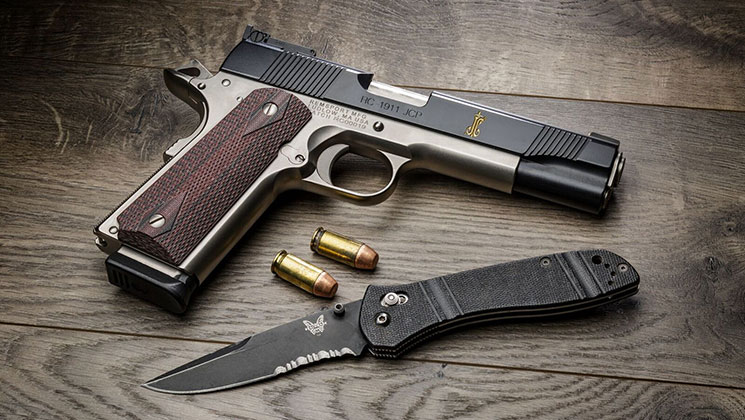
The only good thing about a Texas drought is that there are fewer watering holes for game. As we drove out onto a dirt dam near the edge of the ranch, we caught a lone boar crossing the jeep track on top of the dam. The vehicle seemed to confuse him, and in his panic, he turned back toward the pond rather than continuing on his intended path. Once off the road, he realized his mistake and changed course, running in our direction along the side of the dam apparently intending to pass us before re-crossing the dirt road. I had just emerged from the Jeep and gotten my feet under me when he burst through the brush on the edge of the road less than five yards from me. Amazing myself (and making all my Gunsite instructors proud) I had the Kimber out and delivered three fast shots, dropping the pig just before he reached the far side of the road. I wish I could tell you I saw four perfect, precise sight pictures (one for each shot and a fourth followup,) and that any one of the three hits would have finished the action. The truth is that I vaguely remember seeing a blurred front sight somewhere on the pig’s body, and that only one of the shot’s would probably have proven fatal in the near future. One shot penetrated the chest cavity right at the diaphragm and while it might not have dropped him on the spot, should have put him down for the count before traveling to far. Another shot broke a front leg where it joins the shoulder. Without the help of coyotes, this may or may not have been fatal. The third shot perforated low in the chest area just under the hide but failed to strike any of the vital organs. Given the toughness of wild boar, I suspect he would have recovered from this one. All three rounds were through and through; unfortunately this boar hadn’t developed any real armor yet.
All that said, I’m rather pleased with my performance and the outcome. My moves were all derived from my training and the repetitive exercises performed in training. In hunting, it’s all about making that first shot conclusive, but once blood is drawn, it’s about finishing the animal. In defensive shooting, once the threat is recognized and a first shot is fired, it’s about finishing the fight. The requirements really are more similar than some folks might think. What really intrigued me was the thought of how much one’s performance might improve if a guy hunted with the same handgun he carried for self defense.
Handguns are primarily regarded as defensive weapons, which in our world means their anticipated use is against human threats. Lead free, or all copper bullets, show dramatic terminal performance on soft skinned animals, even when fired at the reduced velocities generated by handguns. But big wild boars are not soft skinned animals. They are densely packed creatures with tough hides and sometimes serious gristle plate for protection. The vaunted stopping power of the .45 ACP fails if sufficient penetration is not achieved. The pigs Mike and I have taken don't make for indisputable proof, but the results are more indicative than 100 rounds into a block of gelatin. If you're looking to enhance your performance to better defend yourself and your family on the mean streets, take your 1911 hunting. Just make sure you match the caliber and ammunition to your quarry.
